How to make the most of your Edu Basic membership
For Who and Why?
Edu Basic membership is designed for K-12, college, and homeschooled students who want to be involved in their learning, not just memorize the right answers. By using Mindomo, you'll engage your mind to question things so you can understand, not just know things. This membership allows you to:
-
create visual representations of your learning material
-
summarize and organize your researched information
-
find key points in books or lessons and illustrate the connections between them
-
review your knowledge before an exam
-
prepare for a speech, etc.
Here's a quick reminder on how Mindomo can make a difference with your school projects, and that there's an entire team here to help.
Improve Your Learning
Practice Deeper Learning

To build your mind map, you need to start asking yourself questions. What is important from what I am reading? Can I organize this information? Do I see any connections? This will help you develop topics, find resources to back up the information, and think critically about it.
Unleash the Power of Visuals

When you hear or read new information, you remember 10% after 3 days. Add images, colors, and shapes, and you'll remember 65%, which means information retention in terms of 'words only' vs. 'words and visuals' is 6 times better.
Use Your Group's Brain Power

Each person has their natural way of exploring ideas. When you ideate with colleagues, you'll come up with different perspectives and learn new things from one another. Synthesizing information from several documents or analyzing scientific data will also be easier and quicker when done collaboratively.
Why Mind Maps?
Fit the way our brain works

Using mind maps for learning fits the way your brain works. That sage saying "a picture is worth a thousand words" is backed up by science. Our brains process visuals 60000 times faster than words. Studies also show our brains not only process visuals faster than words but retain and transmit much more information when it's delivered visually.
Combine right and left hemispheres

Our brains have two major hemispheres, each with its ways of thinking and processing. The left side is logical, linear, and analytical. The right side is intuitive, creative, and visual. Only by using both sides consistently can students grow personally and professionally.
Mind mapping brings right and left brain hemispheres together. Breaking information into concepts and organizing them hierarchically - left hemisphere. Using shapes, pictures, and colors - right hemisphere. The left brain visualizes the overall image, while the right brain identifies all of the steps necessary to complete the map.
Prompt critical thinking
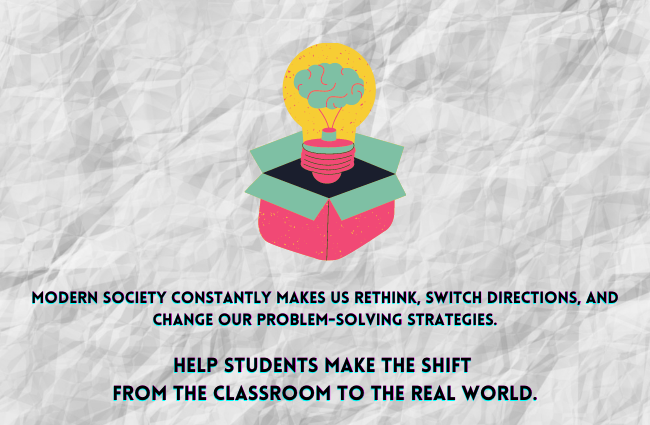
Apart from the visual aspects, the mind map creation process will encourage you to develop a healthy questioning and rationalizing attitude.
First, you'll take the information you know or receive in class and identify the topic or thesis. Then, you'll break everything into smaller pieces, based on importance and hierarchy. Third, you'll put your mind to work and look for connections between new information and what you already know.
During the entire time, you'll be processing information through synthesis, analysis, interpretation, explanation, evaluation, generalization, comparison, and contrast.
What to use Mindomo for?
Brainstorming super fast

Brainstorming is more than just coming up with ideas. It puts us in a creative state of mind and reinforces our curiosity. Being curious opens new perspectives and makes us think critically. Mindomo will let your thoughts flow freely while making connections and quickly moving from one new idea to another.
Tips and Tricks
Unlock your creativity with the predefined template that appeals the most:

Add ideas as they come by using ENTER and TAB from your keyboard. All Mindomo shortcuts can be found here.

Better Note-Taking

Take notes just the way your ideas or information in class come by - spontaneous, countless, not necessarily structured. Later on, reorganize your map in a way that the info makes sense. Because you need to keep it brief (short words/phrases, images, and videos), you're always focusing on the essential things.
Tips and Tricks
Quickly rearrange topics with drag and drop:
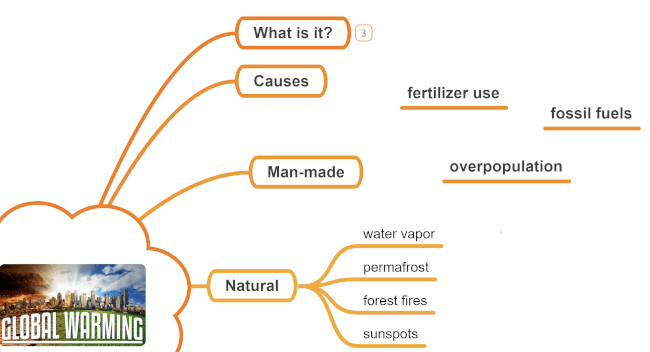
Replace longer words or phrases with symbols that you will remember. This will give you more time to write down core ideas.


X-ray Learning Material

Mind maps have the power to present information in a simple, visual way. Compare a mind map to a city map. The core concept is your city center. Key thoughts in your thinking process are the main roads. Secondary thoughts are secondary roads, and so on. Images and shapes are landmarks of interest or particularly relevant ideas.
Mindomo will help you see what's important, group essential concepts, and look for connections to new and original ideas.
Tips and Tricks
Choose a radial structure to add, connect, and organize associated concepts.


Highlight relevant connections to introduce new concepts:
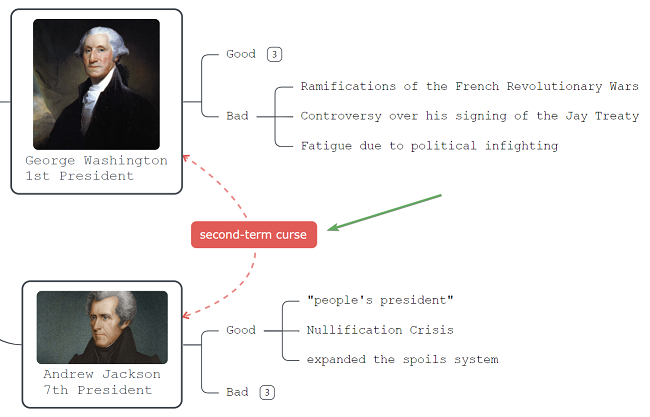
Feel free to use this US Presidents mind map.
Review Multiple Information

Narrow it down, categorize it, and present it in a clear, cohesive format. For this, stick all the info you need on a mind map, may they be ideas, documents, bookmarks, links. You will have everything within reach, ready to be edited and built further.
Tips and Tricks
Expand and collapse the map to navigate from one level to another. Try recalling as many details as you can about the keywords you added. Repetition is the mother of learning.
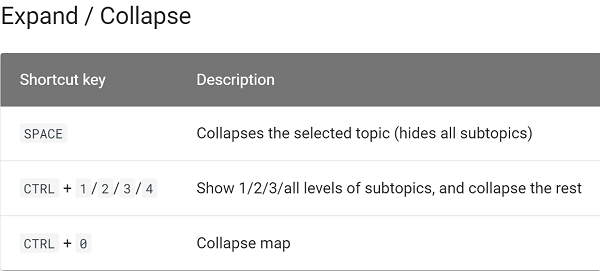
Add comments to the topics that still need your attention.
Use colors and emojis to highlight what's important in terms of definitions, figures, quotes, concepts, deadlines, dates, names, formulas, etc. For example, use the red flag icon for a milestone review. Set a deadline for the exam day as well.

Feel free to adjust this study plan mind map and improve your reviewing skills.
Quick Summarizing

Summarization is good for understanding, retaining, and ultimately recalling information. It can help you become a more purposeful, active reader, thinker, and learner.
If reading for knowledge matters to you, then start summarizing with mind maps.
When creating the mind map, you'll develop a healthy questioning and rationalizing attitude. First, you take the information and identify the main thesis. Second, you break everything into smaller pieces based on importance and hierarchy. Key ideas (chapter numbers, quotes, theories, experiments, author's writing style, personal opinion about the book, etc.) come as main topics, while the details branch out as subtopics. Third, you start looking for connections between the new information and what you already know.
Using shapes, pictures, and colors will make everything stick in your memory. All books, new or read ages ago, will be easily accessible, anytime, anywhere.
Tips and Tricks
Draft a descriptive summary to gain and express your understanding of what the author said in the original text. Use left and/or right org chart layouts to highlight the cause-and-effect relationship between the main points and supporting details.

Build your map with the following framework questions in mind:

Feel free to build upon this descriptive summary mind map.
Choose the evaluative summary when you want to examine the original text for usefulness, validity, the strength of argument, etc.
This summary is opinion-heavy. List a few basic facts such as the title, author, and the main point of the piece, then focus on your evaluation of the reading. Do you like it or dislike it? Why? Do you agree or disagree with the author? Why? Is the piece well-written?
Choose the right and/or left-sided layouts for a more organized overview of the information, displaying it in the exact order of the summary structure. Use colors and emojis to highlight key details from the evaluation paragraph.
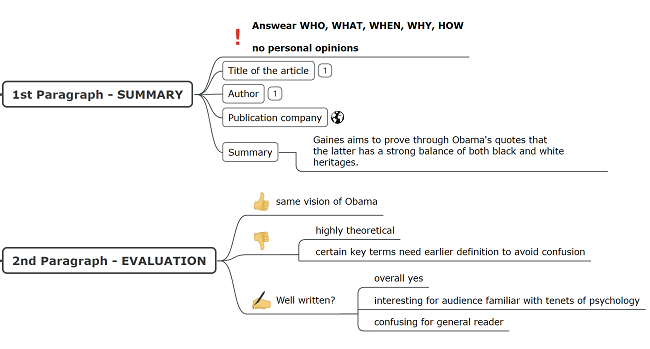
Use this evaluative summary mind map as a starting point for your own diagram.
Essay Writing
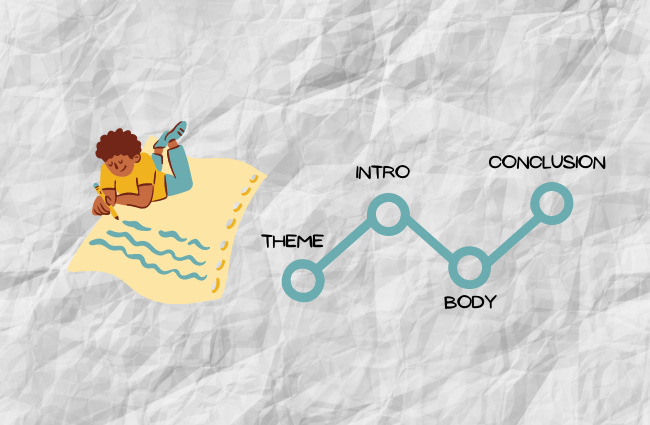
A good essay is structured and organized. It tests your most important reasoning skills like analysis, evaluation, and synthesis. Mindomo can help you go from the complex to the simple, and draft an essay that is clear and on-topic for both you and your audience.
Start with a skeleton that contains everything: research, inspiration from other similar essays, pieces of text, etc.
At first, dump everything you see fit. Then go through the information twice to reorganize it in a way it makes sense. Use colors and shapes for highlights. The more you become familiar with the topic, the easier it will be to write about it.
In the end, aim to create a coherent draft with arguments, counterarguments, examples, quotes, and referenced sources.
Tips and Tricks
Use Mindomo's predefined essay templates as inspiration or ready-to-edit mind maps:
A descriptive essay describes something 鈥� an object or person, an event or place, an experience or emotion, or an idea. The goal is to provide your audience with enough detailed descriptions for them to understand the chosen topic.

Check out this descriptive essay mind map.
At any time, turn your mind map into an outline to lay out what you're going to write:

Editing in the outline view makes writing much easier and brings you closer to the final draft:

If inspiration strikes, write a note for later proofreading:

An argumentative essay uses evidence and facts to support the claim it's making. The goal is to persuade the reader to agree with your argument. Use facts and evidence rather than just your thoughts and opinions.

A narrative essay has a single motif, or a central point, around which the whole narrative revolves - all incidents, happenings, and characters. Similar to a simple five-paragraph essay, it has the same format.

Feel free to use this narrative essay mind map and adjust it to your specific needs.
With an expository essay, the goal is to explain, illustrate, or clarify something in a way that becomes clear for readers. Therefore, it could be an investigation, evaluation, or even argumentation about an idea for clarification.

This type of essay makes room for subcategories like:
- cause-effect essays
- problem-solution essays
- compare-and-contrast essays ( similarities-to-differences, point-to-point, whole-to-whole, etc. )
Since any mind map can be turned into an outline, you can write your essay from scratch and print it directly from Mindomo.
Speech Preparation

The aim of making or even writing a speech is to convince the audience to support your idea or pay attention to the subject of discussion. Either it's a speech for your teachers or colleagues, you should build the foundation of good speech writing.
Before drafting your speech, try answering these questions: Who are you writing for (the audience)? Why are you giving the speech - what do you want the audience to think, feel, or do in response? What will the speech be about (its topic)? How long should it be ( for example, 3 - 5 minutes)?
Tips and Tricks
Choose the right and/or left-sided layouts for a more organized overview of the information. Rank your main points in order of their importance and logical sequence in the speech.

Consider drafting your speech by editing this persuasive essay mind map.
Icons and emojis are ideal for highlighting key aspects - problems, solutions, statistics, explanations, etc.
Sort out any supporting research you need to prove your point. Consider adding videos to help you retain as much valuable information as you can.
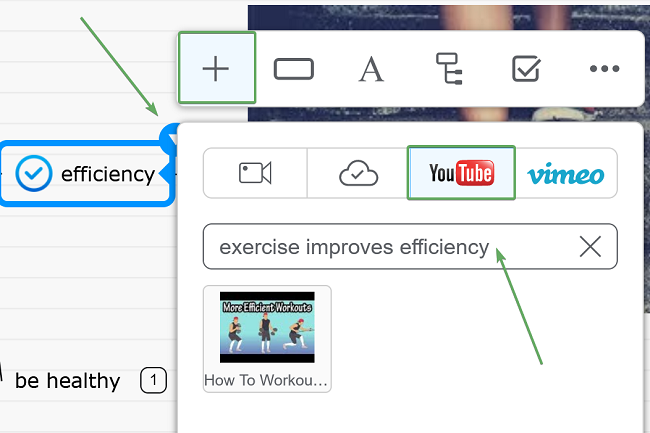
Rehearse before delivering the speech. At the final review, simplify the content, leave only key words and phrases in sight. Use it as a visual aid for speech delivery if you are allowed.

Turn the map into an outline and print it as a handout. This way, the audience can use it as a reference for your presentation.

Class Presentations

No matter how compelling your message is, if you don't showcase it simply, your audience will be a sea of blank faces.
Make relevant presentations straight from the mind map and use them to present your ideas, projects and assignments in a creative way. This will also be time-saving since you'll skip the secondary presentation tool and copying and pasting information from one place to another.
Tips and Tricks
Create an easy-to-follow structure (introduction, body, and conclusion) by using either a mind map or a concept map layout.

Check out this ecology concept map for more inspiration.
Keep your slide deck to 10 slides in total and just six words per slide. This will give the audience a chance to digest the on-screen messages in line with your presentation.

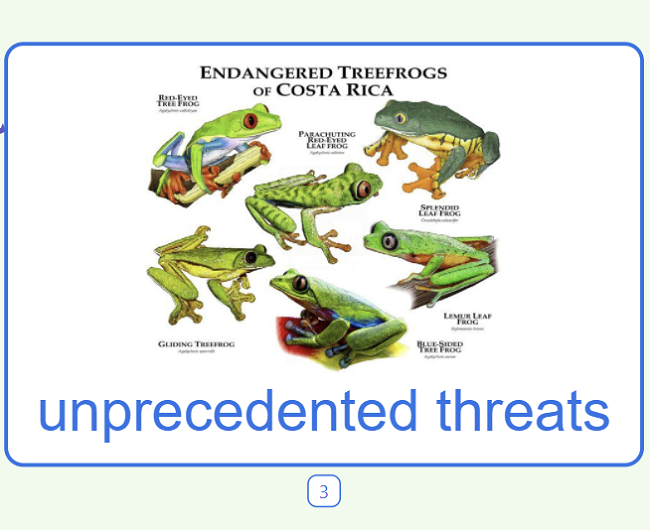
Use compelling images and videos that communicate your ideas and make information easier to remember.
Create a consistent look and feel - stick to 2 or 3 colors, use the same font type, size, color, and formatting in all topics. Format for perfection. You can do this with one topic, then use the copy style option to apply the style to the rest of the content.
For a smooth delivery, keep in mind that Mindomo enables the use of a clicker or remote to help you face the audience and not have to keep turning back to your laptop to change slides.
Integrated Curriculum

Connect different study areas in a cross-disciplinary concept map: history, maths, philosophy, geography, economics, and/or civics. You'll see and understand the connections between disciplines and give meaning to what you're learning.
Tips and Tricks
Highlight the main concepts by using different topic styles for each subject. For example, red for math, blue for philosophy, green for history.
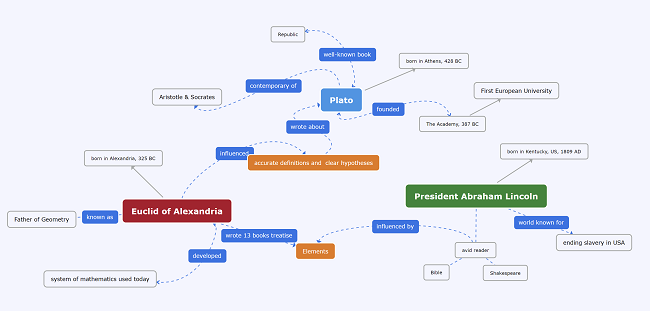
Feel free to use this cross-disciplinary concept map.
Emphasize unifying concepts by using the same color and shape.

Write down short explanations on the relationship lines between the unifying concepts to leave breadcrumbs of your reasoning.


You can read more about concept map creation here.
Research
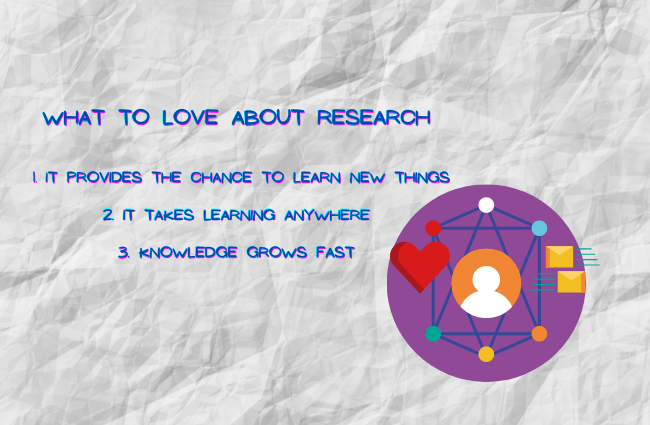
From doing a bit of research for any school project to conducting research as an undergraduate, Mindomo can help you:
- foster critical thinking and analytical skills
- expand knowledge and understanding of a chosen field outside the classroom
The kind of research you do will determine the types of resources you need. Identifying and managing those resources is as important as integrating them into your own words and your research process. Resources are usually:
-
Primary sources (original literary or artistic works of actual events - letters, official records, interviews, survey results, etc.)
-
Secondary sources (discussions, evaluations, syntheses, and analyses of primary resources)
Tips and Tricks
For book excerpts, brochures, journals, magazines, newspapers case studies, etc., you can either take a photo and upload it, or you can create hyperlinks to their location on the web. You can add the hyperlink to a word or phrase or add it as a topic attachment.
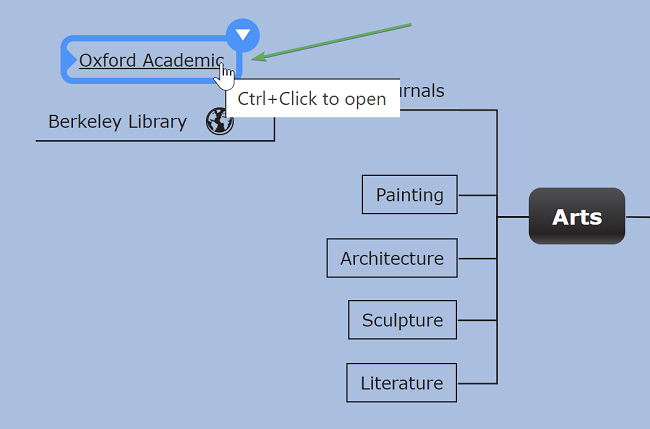

See how you can gather resources in maps such as this Italian Renaissance mind map.
Use any of the Mindomo Bookmarks (text, links, images) relevant to your research:

Save time by copying and pasting info from one map to another, including links, images, notes, and other resources. Read more about it here.


Create notes to keep larger bodies of text hidden from the big picture, for example, long book excerpts. Go over the details if needed without losing your focus.
If you collect research data through observation or experimentation, consider adding personal audio files and even record your speech directly in Mindomo.

At any point, no matter how complex the diagram becomes, you can quickly find specific content using Search and Filter options.